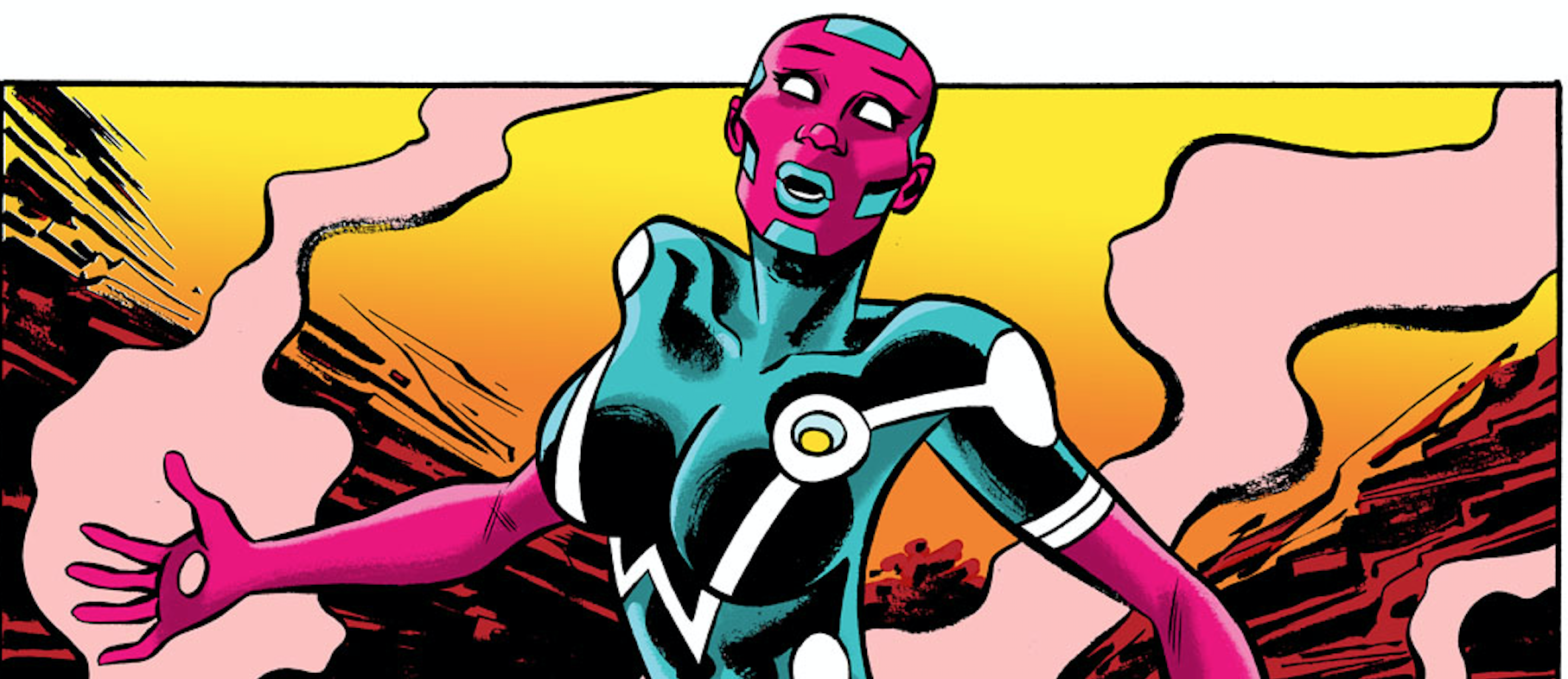I think it’s safe to say that if you follow the Beat, you are familiar with the artistic work of the indefatigable Dean Haspiel.This year has been particularly productive for Haspiel. His prolific work can be seen everywhere, including on television, on the stage (indeed, earlier this fall, his show Harakiri Kane debuted at the Brick Theater in Brooklyn to rave reviews), and of course, appearing underneath the crinkles of a well-loved volume of comics.
Today, Haspiel’s latest work WAR CRY, a sequel to his recently-completed, groundbreaking webcomic series THE RED HOOK, debuts. Taking place within the same New Brooklyn universe, the character of WAR CRY is, according to Haspiel, “a gay, teenage African-American boy who, when he shouts ‘War Cry’ becomes a super goddess; a Human of Mass Destruction.” And from what I’ve read, I can already tell that WAR CRY is an epic yarn filled to the brim with action, suspense, and thrills!
But I wanted to learn more. So, recently, I interviewed Haspiel about the genesis for WAR CRY, the economics of creator-driven webcomics, and the art of creating characters in a shared, epic universe.
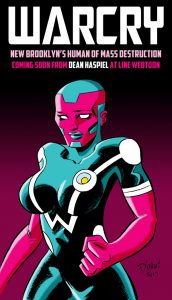
AJ FROST: Firstly, how are you doing? I know that you have been super active recently, with the recent run of your play Harakiri Kane, finishing up your webcomic The Red Hook (which recently won a Ringo Award) and you’re about to start releasing the sequel to Red Hook titled War Cry. How have you been feeling about all these projects that you’ve been working on?
DEAN HASPIEL: Thanks for asking, AJ! My second play, HARAKIRI KANE, enjoyed an incredible, sold out run in November, produced by Gemini CollisionWorks at The Brick Theater in Brooklyn, NY. It’s a story I originally imagined for the screen but would love to adapt into a graphic novel someday. I just handed in the script for my third play that will begin work-shopping soon. I’m currently drawing WAR CRY chapter 17 (of 26) and I’m excited to launch the webcomic.
FROST: The Red Hook is this epic story about a “bad guy,” a thief who becomes a superhero, and its one of the most dynamic explorations of using the vast digital space of the web as the mode of dissemination. What excites you about exploring the ambiguity of “goodness” in your work with Red Hook, and now War Cry?
HASPIEL: Thanks for the cheer! I don’t know anyone who is 100% good and, frankly, those kinds of people make for boring stories. Sorry! I believe most people can be sympathetic to others but not necessarily empathetic. And, that’s a huge difference. To step into another person’s shoes and experience their truth is something most of us can’t do or won’t do. It’s easier to acknowledge pain and struggle and then look the other way or donate to a cause because you’re dealing with your own struggles and pain. People are complex souls and time is an enemy. Some people choose to spend their time understanding others while most people glean a cursory understanding of the human condition, at best, and move on. I’d like to think I observe people well enough to get a good sense but who knows? Our subconscious tends to seek a narrative that supports our personal beliefs rather than energize a third eye for spelunking what’s alien. But, I get it. I’m just as culpable as the next person when it comes to turning a blind eye, but I try to keep an open mind.
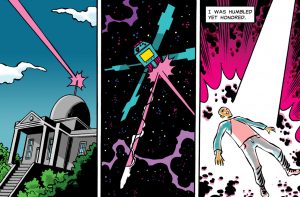
I don’t know how many more times I can become outraged by gun violence, racism, and sexism, but I can ask questions in my work and try to impart good will. So, with that in mind, I find that the bad guys or the misunderstood monsters are much more interesting to navigate because they are the ones who have the most to rehabilitate. Thus, my reasoning for starting The Red Hook‘s story as a super-thief who is forced to become a superhero against his will or he will die and the choices he makes to foster positive change. War Cry has to deal with a lot more than just sharing a body. He/she struggles with purpose over persona while desperately holding onto what makes them individual.
FROST: On the topic of webcomics, what has been the most alluring aspect of releasing stories online at a steady clip? And does the limitless potential of the Internet make you work in a certain way, or put you in a different mindset in contrast to creating and releasing physical works?
HASPIEL: As daunting as immediate responses can be, it’s equally exciting to receive instant reactions to your work and nothing is faster, more encouraging and/or more toxic than the internet. Forget trigger warnings, publishing tests your mettle and helps you grow a thick skin. Which is why I try to keep a healthy distance between and me and my work. Meanwhile, I don’t innovate the format as much as others do. I’ve had to make some adjustments for the vertical scroll but I’m still telling the same story I would in a traditional comic book format. I’m just parsing it a little differently on LINE Webtoon.
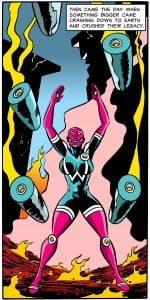
FROST: The character of War Cry is a gay, teenage African-American boy who becomes, as you say, a “Super Goddess” when going into hero mode. When did the idea for War Cry come about? And when did it seem that the potential for the character was there to create a new and separate story?
HASPIEL: I came up with the idea of WAR CRY many years ago but didn’t know where to put it or how to use it. So, it incubated until I created The Red Hook and co-created the New Brooklyn Universe. When I was thinking about a sequel to The Red Hook, I knew I wanted to explore the evolution of heroism and the crisis of identity. WAR CRY is about two very different binary characters who share a non-binary body. After being graced with the power of America’s superheroes (think a bastardized combination of The Avengers and The Justice League of America), a teenage boy named Rajak shouts the words “War Cry!” and instantly evolves into a war goddess, the resurrection of The Red Hook’s dead-girlfriend Ava Blume (think of a mash-up between Shazam and OMAC with Hawk & Dove). It’s a big idea that I explore through the eyes of The Red Hook while presenting the concerns of Rajak and Ava. In some ways, the concept is above my head but I’m not a journalist or a reporter and, instead, I’m a cartoonist who is challenged by the idea of what that might be like and express it in my art. As communication artists, we grow up in public, warts and all, but I won’t let that stop me from telling an existential story that explores the shores of identity.
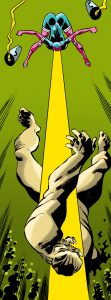
FROST: As I said, The Red Hook is epic in scope and grand in execution, but it’s obvious that the universe you’ve created needs more exploration. When did the idea to do a sequel story become a tangible idea? How much of an influence was Jack Kirby on these projects?
Jack Kirby is the bell I strive to ring every time I tackle a superhero comic book. Kirby is one of the forefathers of the superhero lexicon. I believe the acolytes of Kirby, of which I hesitate to include myself because I don’t know that I have what he had, are unafraid to explore the depths of imagination while making human connections. It’s that very notion that keeps me from suffering writer’s block.
And, yes, there is MUCH MORE of New Brooklyn to explore and make work. The idea of a sentient Brooklyn that’s heart is broken by the apathy and indifference of the world, so much so that it secedes from America to start it’s own republic where art can be bartered for food and services, is a fantasy that could probably never really happen but, like a Jack Kirby comic book that asks questions about God and then dares to answer them, WHY NOT put out stuff that might could alter the tide of the human condition? That might could help affect change? I’m no kinda revolutionary but art has proven to influence and innovate.
FROST: What are your thoughts on the economics of doing epic stories like War Cry, and the Red Hook before it, and releasing them for free on the web?
HASPIEL: If it’s good it will sell. If I give something away for free now, it only helps generate hype and engender word-of-mouth interests. We live in an age where people still covet tactile things and/or wish to gift entertainment. You can’t gift a hyper-link but you can turn someone on. Which is cool! But, free webcomics have many time-released tentacles. You can enjoy them as they get released or you can binge-read it when it’s all said and done. Or, you can buy it later if/when it’s re-packaged for sale. And, we also live during the age of crowdfunding and patrons where fans of the work invest in the creators ability to create more work. Art has become a relationship, more than ever before.
FROST: You’ve worked both in the “corporate” world of comics with the big publishers, but you’re also a pioneer in self-publishing. In your experience with the latter, how has the process changed in the last several years? Has there been more opportunity to explore bigger and bolder stories? Do you see traditional print publishers following suit because of the freedom of creating webcomics has produced so many auteur visions?
HASPIEL: Good questions. I’ll basically say “yes.” Sure. I suppose webcomics carried the torch of the underground and indie/alternative comix until mainstream comics finally bit the proverbial bullet. A classic case of “if you can’t beat ’em, join ’em” economics. The internet helped level the playing field for outlier voices and cost-effective publishing and marketing concerns while equally becoming a focus group for franchise publishers. And, worse, a space for self-entitlement and hate-bait where gossip rules. But, that’s just human nature…. I guess. Anyway, webcomics have changed the way stories can be told and delivered and it’s up to the creatives and their business partners to decide what best fits their projects. Even though I helped pioneer personal webcomics, I think I’ll always prefer to hold and read something printed on paper.
FROST: What are you looking forward to next?
HASPIEL: I’ve written the plot for my third Red Hook story and I have a bunch of other ideas percolating. I’m currently experiencing an autonomous tenure which feels weird and I hope I can continue this ride for my career. And, even though I aim to keep producing creator-owned concepts, it doesn’t mean I don’t have a wild Fantastic Four story up my sleeve, or a great Batman/Superman tale ready to realize.
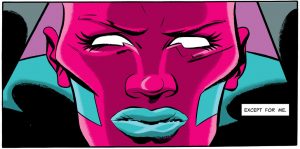
You can read the first THREE chapters of WAR CRY for free HERE!
To follow up on Dean’s latest work, visit his website www.deanhaspiel.com


